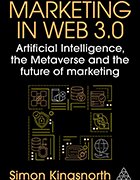How to use IoT for marketing
IoT devices can track people's fitness routines and monitor manufacturing equipment, but they also offer valuable customer data for personalized outreach.
From real-time customer data to memorable experiences, the internet of things can help marketers create highly relevant and engaging campaigns.
 Simon Kingsnorth
Simon Kingsnorth
The internet of things (IoT) is a network of devices that collect data from physical objects and transmit it to the internet. This technology, which has become increasingly prevalent in both consumer and industrial settings, includes glucose monitors, fitness trackers and smart home devices. These devices offer valuable data brands can use to understand customers, but many marketers lack an understanding of how to use it effectively, said Simon Kingsnorth, global marketing expert, bestselling author and CEO at SK strategic marketing agency based in Reading, UK.
Kingsnorth's book, Marketing in Web 3.0: Artificial Intelligence, the Metaverse and the Future of Marketing, explores how brands can use elements of Web 3.0 -- the next evolution of the internet -- to enhance their marketing strategies. These elements include IoT, AI, the metaverse, augmented reality, virtual reality and decentralization. Chapter 10 of the book focuses on IoT for marketing and covers examples, benefits and challenges of the technology and its uses.
Key benefits of IoT for marketing include the following:
- Customer insights. Connected devices, such as smartwatches and fitness trackers, collect real-time customer data that marketers can use to personalize campaigns. For instance, an apparel brand could advertise running shoes to users who run at least two miles weekly.
- Location-based targeting. GPS and RFID technology lets marketers send targeted ads based on a user's location. A restaurant, for example, might send an email offer to people within a certain radius of its location.
- Dynamic pricing. IoT lets brands adjust pricing in real time to account for consumer demand and behavior. For example, some car insurance companies offer pay-as-you-drive policies, which use IoT devices in customers' cars to track their speed and braking habits, Kingsnorth said. Safer drivers can, therefore, receive lower monthly rates.
- Memorable experiences. Brands can use IoT to create unique experiences that set themselves apart from competitors. For instance, a hotel might use smart lightbulbs to let guests control their room's lighting color and brightness from an app on their phones.
The number of IoT devices connected to the internet far exceeds the number of people in the world, offering vast amounts of customer data. However, people have become less willing to share their data due to privacy concerns, Kingsnorth said. To overcome this challenge, marketers can invest in first-party data strategies to collect data from owned channels with explicit consent.
To learn more about IoT in marketing, check out the following excerpt from Chapter 10, "Marketing via the Internet of Things." Visit the Kogan Page site to learn more about the book.
IoT's impact on consumer insights
The integration of IoT into marketing has revolutionized the way customer data is collected. Traditional methods often relied on customer surveys or purchase history, but IoT enables the gathering of more granular data from more touchpoints, allowing for a level of personalization and targeting that previously was unattainable.
IoT devices give a continuous stream of real-time data. This not only provides a deep understanding of customer needs and wants, it also allows companies to adapt in real-time and capitalize on opportunities with agility. As a result, they can make quick, informed decisions and tailor their strategies to actual consumer behaviours as they happen. For example, by using IoT to track supply levels and consumer demand in real-time, companies can adopt dynamic pricing models.
The value of real-time data is seen in smart retail systems that track how customers interact with products in-store, providing insights into shopping behaviours, preferences and even the effectiveness of store layouts. Smart shelves are another example, helping optimize stock levels on the shop floor and in warehouses. When low stock levels are detected on the shop floor, staff can be alerted so they can restock, ensuring customers can always find what they need and optimizing revenues. This method is being applied in warehouses, with low inventory levels prompting automatic reordering.
Perhaps one of the best sources of data is wearable technologies, which help businesses understand the intricacies of product use, such as the frequency of use and length of sessions. Prior to IoT, businesses had no way to gather such information when it came to the use of physical products, but now they can gain comprehensive insights into usage habits. This lets them offer timely upgrades or complementary products in a personalized way. IoT devices can also collect data that helps companies detect and fix problems before they become major issues, improving the customer experience.
The data generated by IoT devices can be used to predict consumer behaviours and trends, enabling businesses to proactively market products and services. For instance, by analysing smart home data, a company can predict when a customer might need a replacement for a home appliance and send them an offer before the customer even realizes the need. Another example is using sensors to monitor the number of people entering and exiting a store or venue -- based on historical data, staffing requirements can be forecast.
Location-based marketing
IoT enables precise location-based marketing strategies. Using GPS and RFID technologies, businesses can send targeted advertisements and offers to consumers based on their real-time location. There is also beacon technology, where small wireless devices use Bluetooth Low Energy (BLE) to transmit signals to nearby smart devices, typically phones or tablets. It's commonly used in retail, museums, airports and event spaces to provide location-based information, navigation assistance, targeted advertising and interaction opportunities. For example, a retail store can use beacon technology to send special offers to customers' smartphones when they are nearby or in the store, potentially increasing sales. Likewise, a restaurant could send special lunch offers to individuals in nearby office buildings during lunch hours, enhancing the likelihood of attracting customers. Weather data takes things a step further -- current conditions and forecasts can be leveraged, increasing the relevance of offers.
Smart billboards are another form of location-based advertising using IoT technology. These billboards collect mobile data from passing devices (for example, GPS data showing that the individual visited Burger King). It then aggregates that data, inferring likely preferences based on the preferences of other users that have visited Burger King. Essentially, it uses a probabilistic model to assess the likely choices of users based on shared behaviour patterns. Based on its conclusions, it can display the right ads at the right time -- those that are most likely to convert the people nearby in any given moment. A platform called RADAR by Clear Channel Outdoor Americas (CCOA) was launched in 11 cities that does what I just described. Also note that these applications don't collect personal data (Pymnts, 2016).
Another, simpler example is the use of sensors in venues to monitor foot traffic and adjust the placement ads in real-time to maximize exposure.
Creating unique customer experiences
IoT not only improves the overall customer experience, it can create memorable experiences that differentiate brands. For example, hotels are now using smart room technology -- the guest's smartphone becomes a remote control for lighting, heating and other IoT-enabled appliances in the room. Then there are smart fitting rooms for retail, which bring many benefits for customers and businesses alike. Sensors can identify the items a customer brings into the fitting room, then connected screens and mirrors display information on complementary items, colour variations and sizes that are in stock in that specific store, in other stores or online. They can also request for staff to bring items -- much more convenient than getting dressed, looking for the items, queueing up again and starting over. Retailers also get to up-sell, cross-sell and gather more data.
The example above shows how IoT helps create omnichannel experiences, where offline and online marketing channels are interconnected. IoT devices will bridge the gap between physical and digital worlds, providing a cohesive experience across various touchpoints and offering more detailed and accurate customer journey mapping.
Now for an example involving wearables. Nivea's IoT print ad in Rio de Janeiro enhanced the experience of families visiting the beach and demonstrated care for the company's customers. Together with the launch of a new sunscreen product for children, the company printed an ad containing a GPS-enabled bracelet. On the beach, children could wear the bracelet and their caregivers would be notified if they moved beyond a safe distance.
Customer experiences at events are also improving thanks to beacon technology. Consider a large exhibition, for example -- wearables can gather data on where each user has spent time so they may be notified about similar, upcoming sessions or other relevant exhibitors. They also improve navigation through large venues, giving tips on the best routes to different areas.
Companies are combining IoT with gamification to create engaging experiences. A classic example is Fitbit. When users get started with the app, they're prompted to connect to Facebook and engage with friends that are also using Fitbit, enabling users to share progress and set up challenges. The social element makes it all the more powerful and is key to making such campaigns go viral.
Aside from the direct benefits that IoT brings customers, the operational improvements it creates behind the scenes improve their experiences as well. Again, IoT in retail is promising in this way, as optimized layouts could help optimize foot traffic and prevent crowds. Electronic shelf labels provide up-to-date pricing information -- not only does this save retailers the huge amounts of time they spend updating labels manually, it also helps manage customer expectations and eliminate the frustration of going to pay for an item only to discover its actual price is not as displayed. Likewise, in manufacturing, improved processes ensure minimal downtime, optimal productivity and therefore that products are available for customers when they need them.
This extract from Marketing in Web 3.0 by Simon Kingsnorth is ©2024 and reproduced with permission from Kogan Page Ltd.
Tim Murphy is associate site editor for Informa TechTarget's Customer Experience and Content Management sites.







